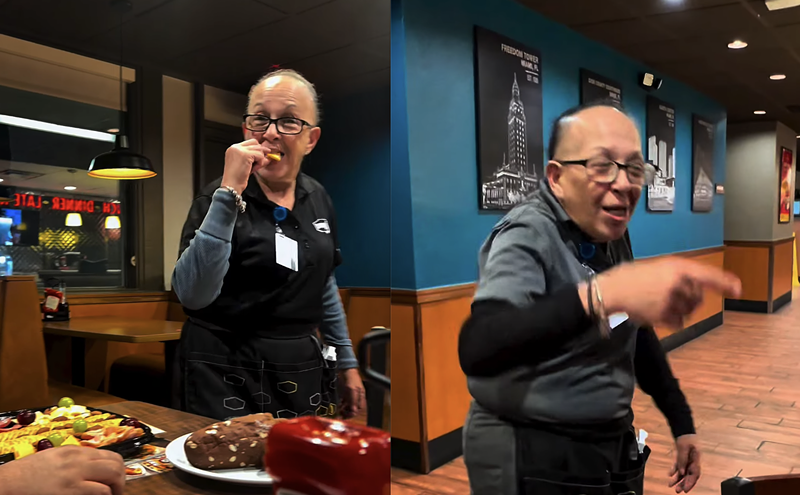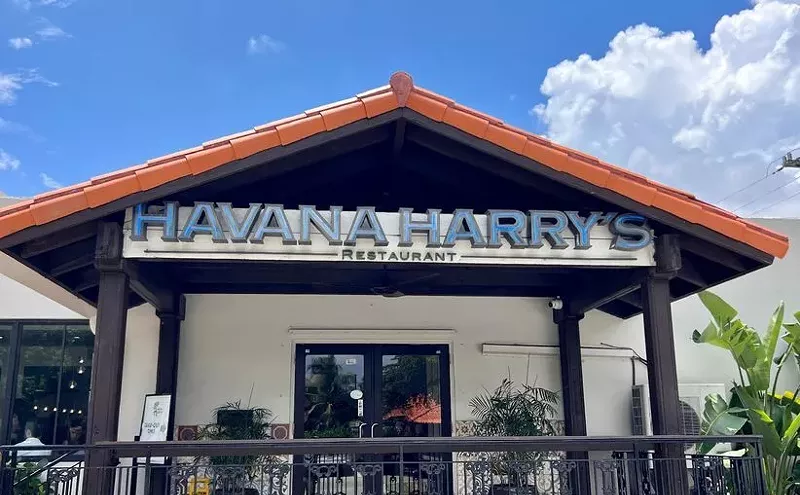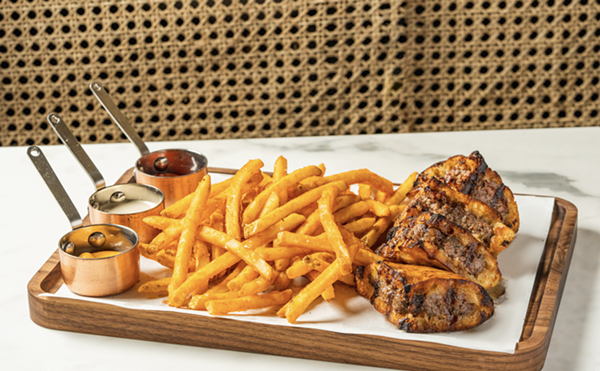In twentieth-century America, east -- the Far East -- is a trend the way west once was. Its influence can be determined in everything from religion to exercise programs, and most especially in cuisine. Perhaps not surprisingly, given its geographic location and historic significance, northern California was first to absorb this Asian flair. Borrowing heavily from traditional seasonings and cooking methods, innovative nouvelle chefs have gently pushed the Eastern way in a new direction -- toward the succulent grilled fishes and meats of the Pacific Northwest. "Califoriental cuisine" was spawned.
Was it vision or ambition that brought San Franciscan chef Jan Jorgensen and front-runner wife Allison to Coconut Grove? The recent inception of their California-Caribbean Janjo's is certainly an ambitious one: the menu changes nightly, which, while not uncommon, is both an expense and a hassle (for the chef, creatively; for his wife, administratively). In addition, the restaurant refuses to enter the microwave age, and frozen ingredients are equally unacceptable. Much like the Asian preference for keeping their eels live until the oil for cooking them has heated, Jorgensen writes his menu each morning, based on what he can buy fresh.
But Janjo's also entertains a vision. While Califoriental may be common to Californians, it's a culinary art that's new to Miami. And it is art, characterized by an accumulation of flavors that swells into perfect form and remains new and surprising with each bite.
For example, take an empty plate. Call it your palette; consider your relationship to it a creative obligation. First, you may want to prime it. Delicate cream sauces are a favored choice, though you would think nouvelle chefs have been carried away by a river of them. Next, select a grilled something-or-other, preferably free-range and fresh from the farm (or waters). Char it over an exotic wood and some grapevine cuttings (the newest rage -- coconut palms will also do). Add a side of grains, go heavy on the vegetables. Use a combination of ingredients you never thought likely for one of the following: vinaigrette, salsa, remoulade, bechamel, chutney, marmalade, glaze. Garnish with the kitchen sink.
It sounds cynical, but this technique works, particularly at Janjo's, where the Orient has been studied to excellent effect. After dining there, however, I'm less convinced about the Caribbean influence the menu claims is present.
The attempt the Jorgensens made to tailor their vision to the community is commendable. But the intrusion of local flavor is not welcome. No matter how well prepared, there's absolutely nothing unique about Caribbean cuisine in a city where scores of restaurateurs, among other entrepreneurs, attempt to offer imitations of the native cuisine of their southern neighbors.
On further examination, I'm not convinced this menu merits island-reflective at all. It's true that some mango and papaya decorate the dishes. But the addition of tropical fruit, while it can and does enhance it, can't wean the cuisine from its true path, that of the "east-flowing river".
Though not a problem yet, this disparity between menu and cuisine may eventually be misleading, and therefore disappointing. The Jorgensens hopefully have just enough insight to avoid this. The talent in the kitchen, at least, ensures no diner will leave dissatisfied in terms of flavor and quality.
I would advise opening the meal with one of the last legal addictions -- dessert. Detailed by pastry whiz Laura Pariseau, sweets like the wild blueberry and blackberry shortbread Napolean ($5.00) or chocolate velvet vandermint with raspberry compote ($5.00) belong in the front of the menu. Dessert came close to outperforming the meal, which is why I mention first that the butterscotch chocolate eclair ($5.00) was a gooey canoe afloat a marvelous lake of chocolate guilt. The banana-pecan bread pudding ($5.00), laced with caramel, is now considered by this critic to be a personal rite.
Because eating as well as cooking is an expression of creativity, I try to express myself often, and with great variety. Fortunately, my dining companions felt the same. We shared all four main courses, which was helpful in another way -- when I couldn't decide between the sauteed halibut ($16.95) with steamed clams, papaya, cucumber, and yuca chips; and the roast sea bass ($18.95) served with fragrant basmati rice and Chinese black beans, and covered with a shrimp remoulade, we voted. The group wanted grouper (the East coastal translation for sea bass).
In this rare instance, the majority made some wise decisions. The flaky forkfuls were fought over, tine versus tine in a ferocious epicureans' brand of fisticuffs. Also worth fighting for was the crisp, tamarind-glazed duck ($16.95) with lo mein, mushrooms, cashews, and papaya, which may have just edged out the grilled shrimp brochette ($17.95) simply because there was more of this rare bird to enjoy, though the combination of spinach, sweet potatoes, artichokes, and a citrus dressing fleshed out the brochette with tang as well as substance.
The addition of a wood-oven pizza ($11.95), topped with salmon, green onions, and a basil-based cream cheese that looked and tasted like a pesto, pleased as a moderately priced choice. Consumers should be aware, however, that Janjo's offers only two pizzas every evening, preferring to employ their wood-burning stove in the creation of other assorted treats. The portobello mushroom appetizer ($7.00) boasts a turn in the fire, as does the potato-and-goat-cheese terrine ($7.50), garnished with a smoky bacon dressing. This dish featured layers of the bland tuber contrasting sharply with the cheese, much the way lasagne noodles provide an unassuming base for the more obvious ricotta.
The fact that the menu changes nightly means there's a 50-50 chance on any given evening of finding any of the plates mentioned here, but dishes do tend to reappear, sometimes with slight variations. The Caesar salad ($4.75 appetizer size, $7.75 full) seems to be a standard, as do the Bloody Mary oyster shooters ($3.95), though the restaurant had run out of these on our visit. Instead, the waitress offered us a stone crab appetizer which had not been listed on the menu, an item we assumed had just been received that day, and set aside for the following night.
We were tempted further, and followed the river to the egg rolls ($3.95) with an unusual and tangy tomato catsup dip, and the thin slices of tuna ($8.50). This delicacy, dressed in a caper, roast chili, balsamic and soy vinaigrette, and served raw, was delectable beyond description.
As for the main courses, you may find the essentials of the dishes don't change much; that is, the primary ingredients are planetary constants, such as the grilled salmon ($18.50), filet mignon ($21.95), or the veal chop ($18.95). It's the accompanying sauces, vegetables, starches, and garnishes (and sometimes the prices) that act as satellites around them, broadcasting innovation onto what might have been a somewhat standard screen.
JANJO'S 3131 Commodore Plaza, Coconut Grove, 445-5030. Open Sunday-Thursday from 11:30 a.m. to 10:00 p.m., Friday and Saturday from 11:30 a.m. to midnight.










